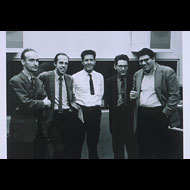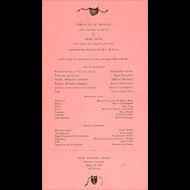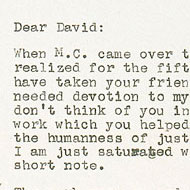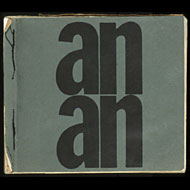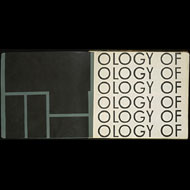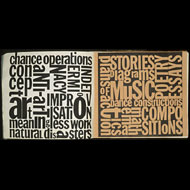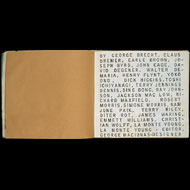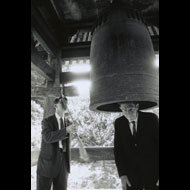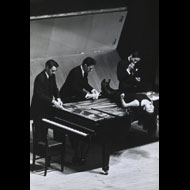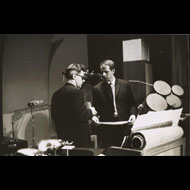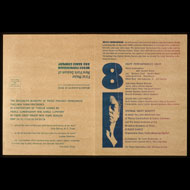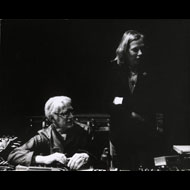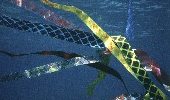Biographies of Artists and Collaborators
Boulez, Pierre (born Montbrison, France, 1925) French composer, conductor, and theorist. Studied harmony at the Paris Conservatoire with Olivier Messiaen and serial techniques with Rene Leibowitz, a pupil of Arnold Schoenberg. Boulez became known in the USA when David Tudor gave the American premiere of his Second Piano Sonata in 1950. Since the mid 1960s, he has devoted his career primarily to conducting and, from 1978, to directing the Institute de Recherche et Coordination Acoustique/Musique (IRCAM), an institute in Paris for training and research in composition, electronic and computer techniques, acoustics, and instrument building.
|
|
|||||
Brecht, George (born New York City, 1926) Sculptor, composer, and performance artist best known for his sculptural assemblages and his association with the Fluxus movement of the 1960s. Studied experimental composition with John Cage from 1958 to 1959 at the New School for Social Research in New York. Composed musical scores through experimentation with chance procedures.
Breer, Robert (born Detroit, Michigan, 1926) American animator and sculptor who lived in Paris from 1949 to 1959. Breer's work focuses on the process of construction and movement in the visual arts. He collaborated with Forrest Myers, Robert Whitman, and David Tudor on the construction of the Pepsi-Cola Pavilion at Expo '70, for which he designed large domed floats.
Brown, Earle (born Lunenburg, Massachusetts, 1926; died Rye, New York, 2002) American composer and pioneer of graphic notation and "open-form" composition. Moved to New York in 1952 to work with John Cage on the Project for Music for Magnetic Tape. Along with Christian Wolff, Morton Feldman, and Cage, Brown was one of the New York School School of composers who emerged in the 1950s. Brown developed time notation, experimented with graphic notation, and, influenced by the painter Jackson Pollock and the sculptor Alexander Calder, pioneered open form composition. He served as composer in residence at the California Institute of the Arts, the University of California at Berkeley, the Peabody Concervatory of Music (which awarded him an honorary doctorate of Music in 1970), Yale University, and Indiana University at Bloomington, among other institutions.
Brown, Jean (born Brooklyn, New York, 1911; died Tyringham, Massachusetts, 1994) Collector who dedicated her life to establishing a study collection of artists' books and objects, printed ephemera, and mail art relating to Dada, Surrealism, Fluxus, and concrete poetry. Brown maintained close friendships with many of the artists whose work she collected, including George Maciunas, Dick Higgins, and Ken Friedman and hosted them in her Shaker seed house in Massachusetts. Her papers are held in the special collections of the Research Library at the Getty Research Institute.
Bussotti, Sylvano (born Florence, Italy, 1931) Italian composer best known for his highly visual graphic scores and his experimentation with new compositional techniques. He was controversial in the 1950s and 1960s for the erotic and sado-masochistic nature of his works, including Five Piano Pieces for David Tudor, composed in 1958. From the mid 1970s he turned towards multimedia theatrical productions dubbed BUSSOTTIOPERABALLET by the composer.

Cage, John (born Los Angeles, California, 1912; died New York City, 1992) American composer, philosopher, and writer whose work has had a greater impact on music in the twentieth century than any other American composer. Cage studied counterpoint with Arnold Schoenberg in Los Angeles. In 1938 he took a position as a dance accompanist at the Cornish School of the Arts in Seattle, Washington, where he met his lifelong collaborator Merce Cunningham, for whose dance company Cage would serve as musical director. He composed percussion works for dance that expanded the meaning of "music" to embrace noises produced on everyday objects. He won a Guggenheim fellowship in 1949 for his work with the prepared piano. During the 1950s, while living in New York City, he introduced chance procedures and new forms of graphic notation and created his first works for magnetic tape. His publication of Silence: Lectures and Writing in 1961 drew international acclaim and controversy and prompted commissions for solo instrumental, mixed media, and opera.
Cross, Lowell (born Kingsville, Texas, 1938) Composer known principally for his electronic works with colored laser light. Cross collaborated with David Tudor, John Cage, Marcel Duchamp, Teeny Duchamp, and Gordon Mumma on the 1969 performance of Reunion, a five-hour series of chess games played on an electronically wired chessboard. He co-directed the Tape Music Center at Mills College in Oakland, California, in 1968–69 and collaborated with University of California, Berkeley, sculptor and physicist Carson Jeffries in May 1969 on the multicolor laser light show and electronic music performance Video/Laser I.
Culver, Andrew (born Morristown, New Jersey, 1953) American/Canadian composer, multi-media artist and writer, who was the assistant to John Cage from 1981 until Cage's death in 1992. He programmed software to perform the chance operations central to Cage's work during this period, as well as worked on and directed peformances of all five of Cages "Europeras." Culver is the composer of Ocean 1-95, the orchestral component of Merce Cunningham's Ocean, which was performed in conjunction with David Tudor's electronic score Soundings: Ocean Diary. Conceived and planned by Cage and Cunningham, Ocean marked their final collaboration.
Cunningham, Merce (born Centralia, Washington, 1919) American choreographer and the vanguard figure in modern dance since he founded the Merce Cunningham Dance Company in 1953. He met John Cage at the Cornish Institute in Seattle, Washington, and collaborated with him until Cage's death in 1994. As founder and director of the Merce Cunningham Studio in New York City, he continues to work with experimental composers in the application of chance procedures and open form to choreography.

Davies, Molly (born Kansas City, Missouri, 1944) American filmmaker. Her six-monitor/six-channel video installation David Tudor's Ocean documents Tudor's mise en scène and performance of his electronic score Soundings: Ocean Diary with the Merce Cunningham Dance Company in June 1994 in Amsterdam. Davies produced the film of Jackie Matisse's underwater kites for the collaborative video piece Sea Tails (1983), with electronic sound by Tudor.
Driscoll, John (born Philadelphia, Pennsylvania, 1947) American artist who has collaborated on new performances of David Tudor's electroacoustic environment Rainforest IV since its inception at a workshop led by Tudor in Chocorua, New Hampshire, in 1973. Driscoll was a founding member of Composers Inside Electronics, which grew out of Tudor's workshop.

Fahlström, Öyvind (born São Paolo, Brazil, 1928; died Stockholm, Sweden, 1976) Swedish painter and author whose comic-strip style of painting made him an important figure in the Pop art movement of the 1960s. For the performance series 9 Evenings: Theater and Engineering (1966), sponsored by Experiments in Art and Technology, Fahlström created a "total theater" piece titled Kisses Sweeter than Wine that combined film, sound, and music into one multimedia event.
Feldman, Morton (born New York City, 1926; died Buffalo, New York, 1987) American composer who studied with Wallingford Riegger and Stefan Wolpe. He met John Cage in 1949, a turning point that inspired Feldman to experiment with indeterminacy in composition. Influenced by the painters Jackson Pollock, Mark Rothko, Franz Kline, and Philip Guston, who encouraged him to find a personal, gestural sound world, Feldman devised a form of graph-paper notation that specified only the instrumentation, register, and time structure. After 1953, Feldman abandoned graph-paper notation, and, in the early 1960s, developed a type of "duration free" notation that specifies pitch, but leaves the length of each note to the performer's discretion. From the 1970s Feldman worked exclusively with precise, conventional notation. Feldman held the position of Edgard Varèse Professor of Music at the State University of New York at Buffalo until his death.

Higgins, Dick (born Cambridge, England, 1938; died Quebec City, Canada, 1998) Writer, publisher, artist, film producer, and co-founder of Fluxus and Happenings. He programmed performance and graphic notations for avant-garde theater pieces and musical scores in the 1960s and championed the term "intermedia." A portion of his papers are held in the specital collections of the Research Library at the Getty Research Institute.

Ichiyanagi, Toshi (born Kobe, Japan, 1933) Composer and pianist who performed experimental music involving chance procedures during the 1950s and 1960s. He later became a composer of traditional Japanese music.

Jones, Ralph (born Philadelphia, Pennsylvania, 1951) American musician who has collaborated on new performances of David Tudor's Rainforest IV since its inception at a workshop led by Tudor in Chocorua, New Hampshire, in 1973. Jones was a founding member of Composers Inside Electronics, which grew out of Tudor's workshop.

Kaprow, Allan (born Atlantic City, New Jersey, 1927) Painter and art historian who, in the 1950s, began experimenting with interactive art and sound installations known as "Environments" or "Happenings." His writings on performance art include Assemblage, Environments, and Happenings (1966) and Essays on the Blurring of Art and Life (1993). He taught on the faculty of California Institute of the Arts from 1969 to 1974 and the University of California, San Diego, from 1974 to 1993. His papers are held in the special collections of the Research Library at the Getty Research Institute.
Kluver, Billy (born Monaco, 1927; died Berkeley Heights, New Jersey, 2004) Electrical engineer and author who founded the nonprofit organization Experiments in Art and Technology with Robert Rauschenberg, Robert Whitman, and Fred Waldhauer. He collaborated with David Tudor and nine American artists on the performance series 9 Evenings: Theater and Engineering (1966) at the Armory Center in New York City and on the Pepsi-Cola Pavilion for Expo '70 in Osaka, Japan. The Experiments in Art and Technology Records are held in the special collections of the Research Library at the Getty Research Institute.

Matisse, Jackie (born Paris, 1931) French artist who creates kite and kitetail sculptures. She collaborated with David Tudor and filmmaker Molly Davies on the three-screen video of her underwater kites Sea Tails (1983) and with Tudor on the kite installation piece Lines and Reflections (1987–1988). Other collaborative projects with Tudor include Tailing a Dream (1985), 9 Lines, Reflected (1986), Volatils with Sonic Reflections (1990), and Virtual Focus (1990). Until 1954 she lived in New York, where her father Pierre Matisse, son of the French artist Henri Matisse, ran his now historic gallery of modern art. Since then she has lived in Paris. Between 1959 and 1968 she assisted her stepfather Marcel Duchamp in assembling his Bôite-en-valise (portable museum), and she is the keeper of the Duchamp archives. Also known as Jacqueline Matisse Monnier.
Mumma, Gordon (born Framingham, Massachussetts, 1935) Experimental musician and composer. From 1953 to 1966 Mumma lived in Ann Arbor, Michigan, where with Robert Ashley he co-founded the Cooperative Studio for Electronic Music and the now historic ONCE Festivals of Contemporary Music. He worked alongside David Tudor and John Cage as a composer and musician for the Merce Cunningham Dance Company.
Myers, Forrest (born Long Beach, California, 1941) American sculptor known in the 1960s for his experimentation with monumental light sculpture. He collaborated with David Tudor, Robert Breer, Forrest Myers, and Robert Whitman on the Pepsi-Cola Pavilion at Expo '70 in Osaka, Japan, for which he designed a sculpture made of fog.

Oliveros, Pauline (born Houston, Texas, 1932) American performer and composer who has deeply influenced American music since the 1960s through her work with improvisation, meditation, electronic music, myth, and ritual. The first director of the Center for Contemporary Music (formerly the Tape Music Center at Mills College), Oliveros went on to direct the Center for Music Experiment at the University of California, San Diego (1976–1979), and to teach at Mills College in Oakland, California, as Darius Milhaud Professor of Composition (1996–1999). In performance Oliveros uses an electronically enhanced accordian that has been retuned according to two different systems of just intonation. She runs the Deep Listening program of the Pauline Oliveros Foundation, Inc., which she founded in 1985. (Oliveros may be heard participating in the David Tudor Symposium Panel of David Tudor's Friends and Collaborators.)
Ono, Yoko (born Tokyo, Japan, 1933) Japanese-born singer and performance artist who moved to New York in 1953 and became active in the early 1960s in Manhattan's conceptual art and Fluxus circles. Ono married John Lennon in 1969 and worked with him on recordings of rock music, improvised vocals, and electronic music.

Rainer, Yvonne (born San Francisco, California, 1934) After training as a modern dancer in New York, Rainer began to choreograph her own work in 1960. As one of the founders of the Judson Dance Theater in 1962, she presented new choreography in the USA and Europe (1962–1975). In 1968 she began to incorporate short films into her live performances and produced her first feature-length film, Lives of Performers, in 1972. The Museum of Modern Art in San Francisco and the Film Society of Lincoln Center held complete retrospectives of Rainer's films in 1997.
Richards, Mary Caroline (born Idaho, 1928; died New York City 1994) American writer and potter who taught on the faculty of Black Mountain College in Asheville, North Carolina (1945–1951). Richards met David Tudor at Black Mountain, and in 1954 they joined the Stony Point Collective, founded by Paul Williams, in upstate New York. She pursued a career as a pottery instructor and author of books on art education. Her papers are held in the special collections of the Research Library at the Getty Research Institute.
Rigg, Jean (born Chicago, Illinois, 1938) Manager of the Merce Cunningham Dance Company from 1968 to 1976 and close friend and advisor to David Tudor.
Riley, Terry (born Colfax, California, 1935) American composer and performer who experimented with echo effects and the technology of tape recording that developed in the 1960s. His musical score In C (1964) was one of the first works to bring compositional minimalism to a mainstream audience. Influenced by modal jazz and Indian classical music, Riley is known for his extensive keyboard improvisations. He studied with musician Pandit Pran Nath from 1970 until the Indian master's death in 1996.

Schneemann, Carolee (born Fox Chase, Pennsylvania, 1939) American performance artist, experimental filmmaker, and painter. Schneemann's multimedia performances and solo improvisational work often make provocative use of her nude body to explore sexual taboos and feminism. A portion of the Schneemann archive is held in the special collections of the Research Library at the Getty Research Institute.
Stockhausen, Karlheinz (born Burg Mödrath, Germany, 1928) One of the most influential composers of the post-1945 avant-garde and a pioneer of electronic music. Stockhausen studied in Paris with Olivier Messiaen, met Pierre Boulez, who introduced him to musique concrète (tape music) and to the Parisian avant-garde, and, in 1953, returned to Cologne to work under Herbert Eimert at the Studio für Elektronische Musik at Nordwestdeutscher Rundfunk. From 1956, he regularly taught summer courses in Darmstadt, where he championed the music of John Cage. In 1967, he married the painter Mary Bauermeister, who held performances of new music in her gallery in Cologne. By the late 1960s, recordings of Stockhausen's music sold more copies than those of any other composer except Igor Stravinsky. This fame receded during the 1970s, when his activity focused increasingly on his seven-part operatic cycle, Licht. In 1972 he established his own publishing house, and in 1994 he founded the Stockhausen Stiftung für Musik, which includes a Stockhausen archive.

Viola, Bill (born New York City, 1951) American video and sound installation artist who has worked in the vanguard of electronic media since the early 1970s. Viola participated in David Tudor's workshop on Rainforest IV in 1973 and became a founding member of the group Composers Inside Electronics, which grew out of the workshop. His work treats sound as a vital component of video and incorporates new technologies and formats (large screen, videotape, film, site-specific work) and diverse sources from travels to the South Pacific and the Himalayas.
Whitman, Robert (born New York City, 1935) American artist who became known in the 1960s for his designs of environments that incorporated live performance, slide projection, film, and lasers. He collaborated with David Tudor as one of four core artists on the Pepsi-Cola Pavilion at Expo '70 in Japan, for which he designed the central performance arena.
Wolff, Christian (born Nice, France, 1934) Wolff moved in 1941 to the United States, where he studied classics and became a classics professor at Harvard. In 1970 he was appointed professor of classics and music at Dartmouth College. Almost entirely self-taught in music, Wolff worked with John Cage, Earle Brown, and Morton Feldman during the 1950s as part of the "New York School." His indeterminate music, including pieces written for David Tudor, introduced a technique of "cueing" in which the actions of one performer are directed by the sounds of another.
Wolpe, Stefan (born Berlin, Germany, 1902; died New York City, 1972) American composer of German birth. Wolpe's first published work, an adagio for piano, appeared in 1920 in the German magazine, Melos. In 1923 he became active as a pianist and composer for the Novembergruppe, an association of socialist artists. He attended lectures and exhibitions at the Bauhaus at Weimar and was influenced by multimedia performances at the school. Wolpe fled Weimar for Vienna in 1933, where he studied with Anton von Webern. At the end of 1933, he fled again, first to Palestine, and in 1938 to the United States. His American posts included a directorship of music at Black Mountain College (1952–1956). Wolpe's works of the 1940s combined chromatic and serial composition with classical harmony. His populism led him to work during the 1940s and 1950s with jazz musicians interested in broadening the parameters of concert music.
Young, La Monte (born Bern, Idaho, 1935) Young grew up and studied in Los Angeles and Berkeley. He moved to New York on a university traveling fellowship to study at the New School for Social Research, and directed the first loft-concert series with Yoko Ono in 1960–1961. Young edited the proto-Fluxus publication, An Anthology of Chance Operations, designed by George Maciunas, in 1962. From 1963 to the present, Young has collaborated with painter and calligrapher Marian Zazeela on site-specific sound and light environments called "Dream Houses," featuring his continuous drone music.

Breer, Robert (born Detroit, Michigan, 1926) American animator and sculptor who lived in Paris from 1949 to 1959. Breer's work focuses on the process of construction and movement in the visual arts. He collaborated with Forrest Myers, Robert Whitman, and David Tudor on the construction of the Pepsi-Cola Pavilion at Expo '70, for which he designed large domed floats.
Brown, Earle (born Lunenburg, Massachusetts, 1926; died Rye, New York, 2002) American composer and pioneer of graphic notation and "open-form" composition. Moved to New York in 1952 to work with John Cage on the Project for Music for Magnetic Tape. Along with Christian Wolff, Morton Feldman, and Cage, Brown was one of the New York School School of composers who emerged in the 1950s. Brown developed time notation, experimented with graphic notation, and, influenced by the painter Jackson Pollock and the sculptor Alexander Calder, pioneered open form composition. He served as composer in residence at the California Institute of the Arts, the University of California at Berkeley, the Peabody Concervatory of Music (which awarded him an honorary doctorate of Music in 1970), Yale University, and Indiana University at Bloomington, among other institutions.
Brown, Jean (born Brooklyn, New York, 1911; died Tyringham, Massachusetts, 1994) Collector who dedicated her life to establishing a study collection of artists' books and objects, printed ephemera, and mail art relating to Dada, Surrealism, Fluxus, and concrete poetry. Brown maintained close friendships with many of the artists whose work she collected, including George Maciunas, Dick Higgins, and Ken Friedman and hosted them in her Shaker seed house in Massachusetts. Her papers are held in the special collections of the Research Library at the Getty Research Institute.
Bussotti, Sylvano (born Florence, Italy, 1931) Italian composer best known for his highly visual graphic scores and his experimentation with new compositional techniques. He was controversial in the 1950s and 1960s for the erotic and sado-masochistic nature of his works, including Five Piano Pieces for David Tudor, composed in 1958. From the mid 1970s he turned towards multimedia theatrical productions dubbed BUSSOTTIOPERABALLET by the composer.
Cage, John (born Los Angeles, California, 1912; died New York City, 1992) American composer, philosopher, and writer whose work has had a greater impact on music in the twentieth century than any other American composer. Cage studied counterpoint with Arnold Schoenberg in Los Angeles. In 1938 he took a position as a dance accompanist at the Cornish School of the Arts in Seattle, Washington, where he met his lifelong collaborator Merce Cunningham, for whose dance company Cage would serve as musical director. He composed percussion works for dance that expanded the meaning of "music" to embrace noises produced on everyday objects. He won a Guggenheim fellowship in 1949 for his work with the prepared piano. During the 1950s, while living in New York City, he introduced chance procedures and new forms of graphic notation and created his first works for magnetic tape. His publication of Silence: Lectures and Writing in 1961 drew international acclaim and controversy and prompted commissions for solo instrumental, mixed media, and opera.
Cross, Lowell (born Kingsville, Texas, 1938) Composer known principally for his electronic works with colored laser light. Cross collaborated with David Tudor, John Cage, Marcel Duchamp, Teeny Duchamp, and Gordon Mumma on the 1969 performance of Reunion, a five-hour series of chess games played on an electronically wired chessboard. He co-directed the Tape Music Center at Mills College in Oakland, California, in 1968–69 and collaborated with University of California, Berkeley, sculptor and physicist Carson Jeffries in May 1969 on the multicolor laser light show and electronic music performance Video/Laser I.
Culver, Andrew (born Morristown, New Jersey, 1953) American/Canadian composer, multi-media artist and writer, who was the assistant to John Cage from 1981 until Cage's death in 1992. He programmed software to perform the chance operations central to Cage's work during this period, as well as worked on and directed peformances of all five of Cages "Europeras." Culver is the composer of Ocean 1-95, the orchestral component of Merce Cunningham's Ocean, which was performed in conjunction with David Tudor's electronic score Soundings: Ocean Diary. Conceived and planned by Cage and Cunningham, Ocean marked their final collaboration.
Cunningham, Merce (born Centralia, Washington, 1919) American choreographer and the vanguard figure in modern dance since he founded the Merce Cunningham Dance Company in 1953. He met John Cage at the Cornish Institute in Seattle, Washington, and collaborated with him until Cage's death in 1994. As founder and director of the Merce Cunningham Studio in New York City, he continues to work with experimental composers in the application of chance procedures and open form to choreography.
Davies, Molly (born Kansas City, Missouri, 1944) American filmmaker. Her six-monitor/six-channel video installation David Tudor's Ocean documents Tudor's mise en scène and performance of his electronic score Soundings: Ocean Diary with the Merce Cunningham Dance Company in June 1994 in Amsterdam. Davies produced the film of Jackie Matisse's underwater kites for the collaborative video piece Sea Tails (1983), with electronic sound by Tudor.
Driscoll, John (born Philadelphia, Pennsylvania, 1947) American artist who has collaborated on new performances of David Tudor's electroacoustic environment Rainforest IV since its inception at a workshop led by Tudor in Chocorua, New Hampshire, in 1973. Driscoll was a founding member of Composers Inside Electronics, which grew out of Tudor's workshop.
Fahlström, Öyvind (born São Paolo, Brazil, 1928; died Stockholm, Sweden, 1976) Swedish painter and author whose comic-strip style of painting made him an important figure in the Pop art movement of the 1960s. For the performance series 9 Evenings: Theater and Engineering (1966), sponsored by Experiments in Art and Technology, Fahlström created a "total theater" piece titled Kisses Sweeter than Wine that combined film, sound, and music into one multimedia event.
Feldman, Morton (born New York City, 1926; died Buffalo, New York, 1987) American composer who studied with Wallingford Riegger and Stefan Wolpe. He met John Cage in 1949, a turning point that inspired Feldman to experiment with indeterminacy in composition. Influenced by the painters Jackson Pollock, Mark Rothko, Franz Kline, and Philip Guston, who encouraged him to find a personal, gestural sound world, Feldman devised a form of graph-paper notation that specified only the instrumentation, register, and time structure. After 1953, Feldman abandoned graph-paper notation, and, in the early 1960s, developed a type of "duration free" notation that specifies pitch, but leaves the length of each note to the performer's discretion. From the 1970s Feldman worked exclusively with precise, conventional notation. Feldman held the position of Edgard Varèse Professor of Music at the State University of New York at Buffalo until his death.
Higgins, Dick (born Cambridge, England, 1938; died Quebec City, Canada, 1998) Writer, publisher, artist, film producer, and co-founder of Fluxus and Happenings. He programmed performance and graphic notations for avant-garde theater pieces and musical scores in the 1960s and championed the term "intermedia." A portion of his papers are held in the specital collections of the Research Library at the Getty Research Institute.
Ichiyanagi, Toshi (born Kobe, Japan, 1933) Composer and pianist who performed experimental music involving chance procedures during the 1950s and 1960s. He later became a composer of traditional Japanese music.
Jones, Ralph (born Philadelphia, Pennsylvania, 1951) American musician who has collaborated on new performances of David Tudor's Rainforest IV since its inception at a workshop led by Tudor in Chocorua, New Hampshire, in 1973. Jones was a founding member of Composers Inside Electronics, which grew out of Tudor's workshop.
Kaprow, Allan (born Atlantic City, New Jersey, 1927) Painter and art historian who, in the 1950s, began experimenting with interactive art and sound installations known as "Environments" or "Happenings." His writings on performance art include Assemblage, Environments, and Happenings (1966) and Essays on the Blurring of Art and Life (1993). He taught on the faculty of California Institute of the Arts from 1969 to 1974 and the University of California, San Diego, from 1974 to 1993. His papers are held in the special collections of the Research Library at the Getty Research Institute.
Kluver, Billy (born Monaco, 1927; died Berkeley Heights, New Jersey, 2004) Electrical engineer and author who founded the nonprofit organization Experiments in Art and Technology with Robert Rauschenberg, Robert Whitman, and Fred Waldhauer. He collaborated with David Tudor and nine American artists on the performance series 9 Evenings: Theater and Engineering (1966) at the Armory Center in New York City and on the Pepsi-Cola Pavilion for Expo '70 in Osaka, Japan. The Experiments in Art and Technology Records are held in the special collections of the Research Library at the Getty Research Institute.
Matisse, Jackie (born Paris, 1931) French artist who creates kite and kitetail sculptures. She collaborated with David Tudor and filmmaker Molly Davies on the three-screen video of her underwater kites Sea Tails (1983) and with Tudor on the kite installation piece Lines and Reflections (1987–1988). Other collaborative projects with Tudor include Tailing a Dream (1985), 9 Lines, Reflected (1986), Volatils with Sonic Reflections (1990), and Virtual Focus (1990). Until 1954 she lived in New York, where her father Pierre Matisse, son of the French artist Henri Matisse, ran his now historic gallery of modern art. Since then she has lived in Paris. Between 1959 and 1968 she assisted her stepfather Marcel Duchamp in assembling his Bôite-en-valise (portable museum), and she is the keeper of the Duchamp archives. Also known as Jacqueline Matisse Monnier.
Mumma, Gordon (born Framingham, Massachussetts, 1935) Experimental musician and composer. From 1953 to 1966 Mumma lived in Ann Arbor, Michigan, where with Robert Ashley he co-founded the Cooperative Studio for Electronic Music and the now historic ONCE Festivals of Contemporary Music. He worked alongside David Tudor and John Cage as a composer and musician for the Merce Cunningham Dance Company.
Myers, Forrest (born Long Beach, California, 1941) American sculptor known in the 1960s for his experimentation with monumental light sculpture. He collaborated with David Tudor, Robert Breer, Forrest Myers, and Robert Whitman on the Pepsi-Cola Pavilion at Expo '70 in Osaka, Japan, for which he designed a sculpture made of fog.
Oliveros, Pauline (born Houston, Texas, 1932) American performer and composer who has deeply influenced American music since the 1960s through her work with improvisation, meditation, electronic music, myth, and ritual. The first director of the Center for Contemporary Music (formerly the Tape Music Center at Mills College), Oliveros went on to direct the Center for Music Experiment at the University of California, San Diego (1976–1979), and to teach at Mills College in Oakland, California, as Darius Milhaud Professor of Composition (1996–1999). In performance Oliveros uses an electronically enhanced accordian that has been retuned according to two different systems of just intonation. She runs the Deep Listening program of the Pauline Oliveros Foundation, Inc., which she founded in 1985. (Oliveros may be heard participating in the David Tudor Symposium Panel of David Tudor's Friends and Collaborators.)
Ono, Yoko (born Tokyo, Japan, 1933) Japanese-born singer and performance artist who moved to New York in 1953 and became active in the early 1960s in Manhattan's conceptual art and Fluxus circles. Ono married John Lennon in 1969 and worked with him on recordings of rock music, improvised vocals, and electronic music.
Rainer, Yvonne (born San Francisco, California, 1934) After training as a modern dancer in New York, Rainer began to choreograph her own work in 1960. As one of the founders of the Judson Dance Theater in 1962, she presented new choreography in the USA and Europe (1962–1975). In 1968 she began to incorporate short films into her live performances and produced her first feature-length film, Lives of Performers, in 1972. The Museum of Modern Art in San Francisco and the Film Society of Lincoln Center held complete retrospectives of Rainer's films in 1997.
Richards, Mary Caroline (born Idaho, 1928; died New York City 1994) American writer and potter who taught on the faculty of Black Mountain College in Asheville, North Carolina (1945–1951). Richards met David Tudor at Black Mountain, and in 1954 they joined the Stony Point Collective, founded by Paul Williams, in upstate New York. She pursued a career as a pottery instructor and author of books on art education. Her papers are held in the special collections of the Research Library at the Getty Research Institute.
Rigg, Jean (born Chicago, Illinois, 1938) Manager of the Merce Cunningham Dance Company from 1968 to 1976 and close friend and advisor to David Tudor.
Riley, Terry (born Colfax, California, 1935) American composer and performer who experimented with echo effects and the technology of tape recording that developed in the 1960s. His musical score In C (1964) was one of the first works to bring compositional minimalism to a mainstream audience. Influenced by modal jazz and Indian classical music, Riley is known for his extensive keyboard improvisations. He studied with musician Pandit Pran Nath from 1970 until the Indian master's death in 1996.
Schneemann, Carolee (born Fox Chase, Pennsylvania, 1939) American performance artist, experimental filmmaker, and painter. Schneemann's multimedia performances and solo improvisational work often make provocative use of her nude body to explore sexual taboos and feminism. A portion of the Schneemann archive is held in the special collections of the Research Library at the Getty Research Institute.
Stockhausen, Karlheinz (born Burg Mödrath, Germany, 1928) One of the most influential composers of the post-1945 avant-garde and a pioneer of electronic music. Stockhausen studied in Paris with Olivier Messiaen, met Pierre Boulez, who introduced him to musique concrète (tape music) and to the Parisian avant-garde, and, in 1953, returned to Cologne to work under Herbert Eimert at the Studio für Elektronische Musik at Nordwestdeutscher Rundfunk. From 1956, he regularly taught summer courses in Darmstadt, where he championed the music of John Cage. In 1967, he married the painter Mary Bauermeister, who held performances of new music in her gallery in Cologne. By the late 1960s, recordings of Stockhausen's music sold more copies than those of any other composer except Igor Stravinsky. This fame receded during the 1970s, when his activity focused increasingly on his seven-part operatic cycle, Licht. In 1972 he established his own publishing house, and in 1994 he founded the Stockhausen Stiftung für Musik, which includes a Stockhausen archive.
Viola, Bill (born New York City, 1951) American video and sound installation artist who has worked in the vanguard of electronic media since the early 1970s. Viola participated in David Tudor's workshop on Rainforest IV in 1973 and became a founding member of the group Composers Inside Electronics, which grew out of the workshop. His work treats sound as a vital component of video and incorporates new technologies and formats (large screen, videotape, film, site-specific work) and diverse sources from travels to the South Pacific and the Himalayas.
Whitman, Robert (born New York City, 1935) American artist who became known in the 1960s for his designs of environments that incorporated live performance, slide projection, film, and lasers. He collaborated with David Tudor as one of four core artists on the Pepsi-Cola Pavilion at Expo '70 in Japan, for which he designed the central performance arena.
Wolff, Christian (born Nice, France, 1934) Wolff moved in 1941 to the United States, where he studied classics and became a classics professor at Harvard. In 1970 he was appointed professor of classics and music at Dartmouth College. Almost entirely self-taught in music, Wolff worked with John Cage, Earle Brown, and Morton Feldman during the 1950s as part of the "New York School." His indeterminate music, including pieces written for David Tudor, introduced a technique of "cueing" in which the actions of one performer are directed by the sounds of another.
Wolpe, Stefan (born Berlin, Germany, 1902; died New York City, 1972) American composer of German birth. Wolpe's first published work, an adagio for piano, appeared in 1920 in the German magazine, Melos. In 1923 he became active as a pianist and composer for the Novembergruppe, an association of socialist artists. He attended lectures and exhibitions at the Bauhaus at Weimar and was influenced by multimedia performances at the school. Wolpe fled Weimar for Vienna in 1933, where he studied with Anton von Webern. At the end of 1933, he fled again, first to Palestine, and in 1938 to the United States. His American posts included a directorship of music at Black Mountain College (1952–1956). Wolpe's works of the 1940s combined chromatic and serial composition with classical harmony. His populism led him to work during the 1940s and 1950s with jazz musicians interested in broadening the parameters of concert music.
Young, La Monte (born Bern, Idaho, 1935) Young grew up and studied in Los Angeles and Berkeley. He moved to New York on a university traveling fellowship to study at the New School for Social Research, and directed the first loft-concert series with Yoko Ono in 1960–1961. Young edited the proto-Fluxus publication, An Anthology of Chance Operations, designed by George Maciunas, in 1962. From 1963 to the present, Young has collaborated with painter and calligrapher Marian Zazeela on site-specific sound and light environments called "Dream Houses," featuring his continuous drone music.
Image Bank
|
|
|||||
|
|
|||||
|
|
|||||
|
|
|||||
|
|
|||||
|
|
|||||
|
|
|||

